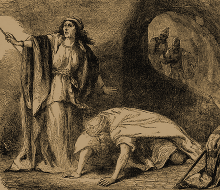Enderal:The Disciplines of Magic
Elementalism is the most widespread of the magical disciplines and an art all its own. Elementalists are able to manipulate the elements of fire, earth, water, and air.
In order to summon a fireball, the Elementalist makes an eventuality come true in which the air's temperature around their hand is increased substantially, to the point of igniting. This condensed heat can subsequently be hurled at a target. Lightning, ice, and earth magics function similarly.
Since Elementalism does not siphon the spirit of the mage or other individuals and draws exclusively from the environment, its use is deemed relatively safe. Abuse can still lead to physical exhaustion, but this would be more related to carelessness of the mage rather than the school of magic itself. Elementalism spells all pack quite a punch, thus making this a very dangerous and offensive art.
Along with Psionics, Entropy makes up the school of Sinistra and is among the most infamous of the magical disciplines. Entropic powers revolve around the manipulation of life and death, the conjuration of supernatural creatures, and the use of necromancy.
An entropic mage brings about eventualities which alter a being's life force. Thus they do not hesitate to revive the deceased by imbuing them with artificial life, deliberately turning them into Lost Ones: undead marionettes bound to the arcanist's will. In addition, Entropists know how to conjure magical anomalies, ranging from ethereal creatures such as wolves, bears, and trolls, to elementals and even otherworldly weapons.
However, the most abominable and dangerous form of Entropy is necromancy. With this discipline, the conjurer is able to focus the energy of Death and use it against their foes. To grasp the underlying process of this kind magic, the student must understand the following: Death is an omnipresent power, inherent in every living being. It is present from the day of one's birth, although during the first two decades of life an individual's life force is sufficiently strong to withstand Death's presence. After this point, it drains one's vitality little by little until it is spent. An Entropist is capable of bringing death that exists in other realities into ours in a controlled manner. This manifests in a fearsome thunderstorm of lightning and fire, the sounds of which resemble the cries of the fallen.
Indeed, necromancy exceeds all other schools in terms of sheer destructiveness, but at the same time, the practice draws upon the arcanist's life force as well. It is not uncommon for Entropists to die from excessive use of their magic themselves.
The use of Entropy is forbidden to Path-abiding arcanists and is punishable as a capital offense. The bone readers of the Skaragg - and, according to rumors, some mercenaries from Melêe - are known to practice it. While the motivation of the latter remains obscure, the Skaragg consider Entropy to be holy - a primitive stance befitting a barbaric, Pathless people. Nevertheless, for reasons unknown, the bone readers seem to be more capable of bearing the physical consequences of the school's use.
Key elements of Skaraggean Entropy include bones and body parts of the deceased, as well as various narcotics of which the bone readers believe they allow them to establish contact with the dead. It is assumed that they believe that the bones function as some sort of "focusing point". Of course, if these barbarians had any proper knowledge about magic, such ostentation would be completely unnecessary.
The Magic of Light - subject to the school of Thaumaturgy - is perhaps the most prestigious of the arcane arts. Its arcanists are capable of curing wounds and diseases, as well as temporarily enhancing either their own or others' stamina and strength to superhuman levels.
The manner in which Light Magic functions can be explained relatively quickly: Upon encountering a physical wound, the Light Mage searches the Sea of Eventualities for a reality containing an intact physique. Through immense mental exertion said reality can be transplanted into ours: broken bones and muscle fibers join together once again, while newly grown tissue and skin close up any open wound.
An arcanist wishing to alter a human's natural attributes would proceed in a similar fashion. For a short period of time a man's strength and, by extension, his muscle fiber, is amplified drastically. Sustaining the necessary connection to the Sea of Eventualities, however, requires the utmost concentration for the duration of the effect. Few Light mages have managed to establish a permanent connection.
Yet one would be incorrect to assume that the Magic of Light could cure any and all defects or diseases, since even relatively mundane application presupposes great magical skill. Furthermore, some diseases in their advanced stages - such as the flesh-maggot plague - are too deeply intertwined with the patient's body to make complete replacement of the infected tissue possible. A similar case would be certain diseases affecting the human mind; numerous experiments have extensively documented the dangers of Light Magic when used to cure cerebral defects, ending either in the patient's sudden brain death or loss of sanity.
For obvious reasons, Light Magic is, as has been mentioned previously, the most prestigious of the diverse magical disciplines. Its study demands the utmost dedication and reputedly coincides with a certain willingness to sacrifice oneself. To some, these requirements elevate talented Light mages to demigods. The Lightborn Erodan is known for his prowess in this school and it is not uncommon to hear pilgrims tell stories of wondrous healings upon visiting one of his shrines.
Mentalism is a discipline of the school of Thaumaturgy. Mentalists are capable of creating physical barriers out of thin air, emitting telekinetic shockwaves, and manipulating objects with the power of their minds.
Similar to the mages of the school of Elementalism, Mentalists focus their spells on their surroundings, and so their usage is relatively free from dangers. If a Mentalist, for instance, wants to push an object from ten feet away, they manifest the truth of an eventuality in which the object is hit and pushed by a random physical impulse. Protective spells - which one may simply refer to as "magical shields" - work in a similar manner. The arcanist channels an eventuality for either a brief moment or an extended period of time in which the air "hardens" around them in a spherical shape.
Mentalism becomes more complicated than Elementalism in that the changes made in the world by the arcanist are not visible to the naked eye and are not permanent, unlike a fire spell's physical impact, which remains even when the mage stops focusing on the possible eventualities. This is why the number of truly capable Mentalists is relatively low. However, their power grows considerably with increasing knowledge of their discipline.
Even though Mentalism is a fairly unknown discipline throughout most countries within the civilized - and uncivilized - world, the Arazealean high priests are widely familiar with Mentalism. Almost every Mentalist who has reached a high level of proficiency in this discipline has studied the work of Arazealean Mentalist Asha He Tis or visited Silvercity personally to study there.
Psionics are subject to the School of Sinistra. Psionicists are skilled at manipulating other people's thoughts and feelings.
While schools like Mentalism - the respectable counterpart of Psionics - or Elementalism concentrate on altering the physical world, Psionicists directly tamper with one's mind. In doing so they force the eyes of their victims to accept an alternative reality as truth to influence their state of mind. Once the spell is cast, the victim can no longer distinguish between the real and fictional world, allowing them to be controlled like a puppet.
To give a tangible example: If a Psionicist is confronted with a group of three mercenaries who are threatening him, he is capable of imprinting the belief that his brothers-in-arms are monstrosities in one of them. Provided the spell is successful, the affected mercenary will then turn on his comrades.
Another, highly dangerous skill within the discipline of Psionics is the ability to make oneself invisible in the minds of one's enemies, using the aforementioned principle of mental manipulation. Psionicists simply let their enemies' eyes see a version of reality in which they are not present.
Similar to Entropy, which is also part of the School of Sinistra, Psionics are one of the most notorious of the magical disciplines. Use of Psionics is a punishable offense in the civilized world. Due to its inherent dangers, the reason for this should be self-evident. Throughout history, an extensive number of renowned personalities and rulers have fallen victim to Psionicists and have committed crimes while under their spell.


